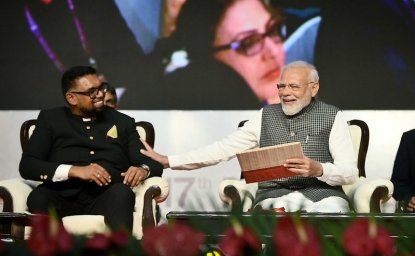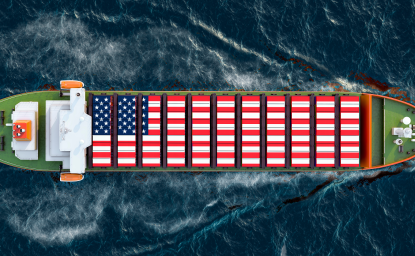Asia on the Brink of (Trade) War?
U.S. withdrawal from the TPP has forced its trading partners and members of the Asia-Pacific region to face divisions over trade strategies, writes Shihoko Goto.
U.S. withdrawal from the TPP has forced its trading partners and members of the Asia-Pacific region to face divisions over trade strategies, writes Shihoko Goto.
With the arrival of Donald Trump in the White House, the priority for global trade now is to avert a trade war. That is a sharp contrast from the sentiment that prevailed only a few weeks ago, which was to establish broader frameworks to make trade more efficient and fair.
President Trump’s decision to pull the United States out of the Trans-Pacific Partnership agreement is a blow for an ambitious deal that has been in the works for years.
Who wants what?
Nevertheless, Washington’s objective should remain unchanged. U.S. businesses want to continue flourishing in the Asia-Pacific region, and the United States wants to continue to attract foreign investment, especially from the Asia.
The uncertainties lie in how the United States’ biggest trading partners may respond to the U.S. withdrawal from TPP, and the impact that may have on economic as well as diplomatic relations.
President Trump’s decision to pull the United States out of the Trans-Pacific Partnership agreement is a blow for an ambitious deal that has been in the works for years.
By announcing his decision for the United States to withdraw from TPP on his first full day in office, Trump has made two things very clear.
First, trade his administration’s top priority. Second, a multilateral approach to establishing new trade rules is no longer deemed attractive.
The President himself argues that the United States can bring its weight to bear much better if it deals exclusively in bilateral situations.
Accordingly, the United States will now look for furthering bilateral free trade agreements as it looks to make “America first,” as outlined in his inauguration speech.
Move on without the U.S.?
But just because the United States is abandoning the multilateral framework to reach free trade deals, other member countries are not throwing in the towel just yet.
Australia, for one, is already pushing for a revised TPP to move forward with the 11 remaining countries, without the United States.
Australia, a long-time U.S. ally, has also made clear that it would be open to having new member countries join a new TPP framework, including China as well as Indonesia.
Japan caught in the middle?
Without the United States included in the deal, Japan would be the biggest economy representing the TPP, and the Japanese parliament ratified the deal earlier this month.
However, Tokyo has been reluctant to espouse the Australian push for proceeding with the pact without the United States.
Prime Minister Shinzo Abe has always emphasized the strategic as much as the economic benefits of the trade deal that would have covered 40% of global GDP.
Whatever the Japanese Prime Minister’s predilections, Tokyo is facing increasing pressure from the new Washington reality of an unrelenting focus on bilateral free trade agreements and enforcing existing trade rules.
Should Abe continue to insist on a multilateral approach for engaging with the United States, it could not only hurt trade relations between Japan and the United States, but also bilateral ties on all issues, including security relations.
The UK angle
Japan’s relations with the Trump administration could contrast sharply with that of Britain under Theresa May. She will be the first world leader to meet with the new U.S. president since his inauguration.
While Abe was the first head of state to meet with Trump since his election, May’s meeting with Trump is expected to herald a new dawn between two countries.
Both countries appear eager to rewrite the international rules that have not only governed world trade over the past few decades, but that have largely been developed by the two countries’ trade lawyers.
Expectations are high that the Trump-May meeting would lead to negotiations for US-UK bilateral free trade agreement, and further enhance relations between two nations under new leaders.
Neither the U.S. nor the UK side seem to worry much about the fact that the British side’s hands are firmly tied with regard to any such trade deal until the UK has completed its exit from the EU (and not just filed for it).
What can Japan offer?
Abe certainly wants to have a strong relationship with the new U.S. administration. With TPP no longer be part of the U.S. trade roadmap, it would seem prudent for Tokyo to follow Washington’s lead and move forward with a bilateral FTA.
U.S. withdrawal from TPP could also be an opportunity for Japan.
The downside of such an approach is that this would likely require Tokyo to offer more concessions to the U.S. side. The alternative is quite unpalatable. It would likely mean pressure from the United States, including raising tariffs and other punitive measures.
Yet, U.S. withdrawal from TPP could also be an opportunity for Japan. It could act itself more as an economic leader in the Asia-Pacific region, filling the vacuum that will be left by the United States.
With or without a large-scale trade deal, there will still be a need to level the playing field. Complex and contentious issues – such as dealing with state-owned enterprises, facilitate e-commerce, and boosting efficiencies in cross-border transactions – have to be dealt with.
All of that can only be sorted out through the establishment of new rules.
For now, though, Japan does not have the appetite to fill that gap. The new trade landscape shaping up in Asia will be less about harmonizing new rules – and much more about averting escalation of tariffs and avoiding a trade war.
This article was originally published in The Globalist.


The Indo-Pacific Program promotes policy debate and intellectual discussions on US interests in the Asia-Pacific as well as political, economic, security, and social issues relating to the world’s most populous and economically dynamic region. Read more



